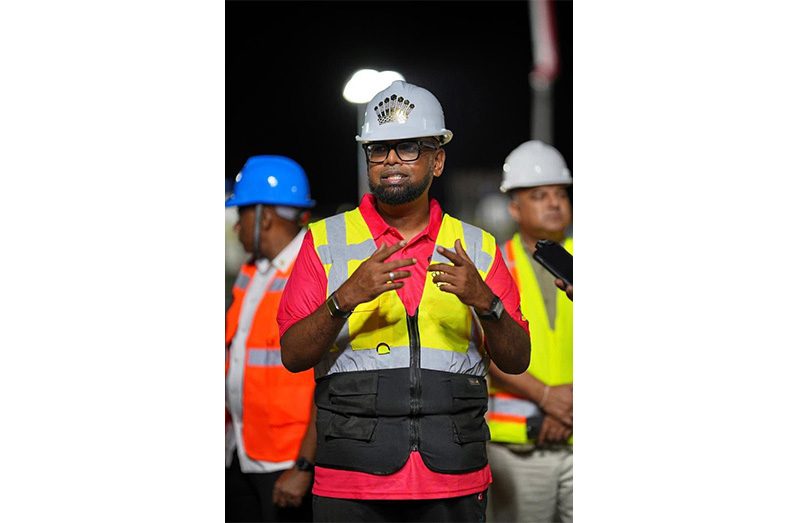GUYANA’S landmark gas-to-energy project is poised to fuel far more than affordable electricity – it will also serve as the foundation for the development of the expansive Wales Development Zone, which is set to host a range of new industries, including a fertiliser plant, data centres, and manufacturing facilities.
President Dr. Mohamed Irfaan Ali visited the project site at Wales, West Bank Demerara, on Friday night, where he observed the accelerated pace of works and provided an update on the broader development plans tied to the initiative.
The 1,400-acre Wales Development Zone is being developed around the core infrastructure of the Gas-to-Energy plant, positioning it as the centrepiece of Guyana’s emerging industrial landscape.
President Ali emphasised that the Gas-to-Energy project is not just about a pipeline and power generation, but about building the foundation for a diversified, production-driven economy. He noted that the integration of industrial facilities within the development zone will help create thousands of jobs, reduce operational costs, and boost competitiveness across multiple sectors.
According to the President, the project represents a major leap toward industrialisation and energy security, transforming Wales into a dynamic economic hub that will power Guyana’s next phase of growth.
“The manufacturing, agro-processing, light industry, all of that, because, as you know, one of the subsets of this entire investment is the reduction in the cost of energy, which will make manufacturing, industrial development, agro-processing, more competitive,” President Ali said.
Aside from those areas, the government is also examining the possibility of a constructing a glass plant.
“The study has been completed on that in relation to the need for glass bottles in the region. We also have the private sector, who are looking at some of these opportunities from a marketing perspective and also from an investment perspective.”
The President also spoke of massive connectivity projects in the pipeline, noting that Region Three will be linked via the Del Conte Road to Bartica, Timehri, the Sand Hill Road, and further on to the new highway leading to Brazil.
INDUSTRIAL DEVELOPMENT
With a firm commitment to diversifying Guyana’s economy, the government is intensifying its focus on industrial development across key regions. President Ali has been a strong advocate for expanding the agro-processing industry, promoting innovation, technology adoption, and partnerships to empower small and medium-sized enterprises (SMEs). At the same time, he continues to champion climate action and public-private collaboration as essential pillars of sustainable growth.
Earlier this year, President Ali announced that Region Three (Essequibo Islands–West Demerara) is on track to become the industrial capital of Guyana. With major infrastructure projects and investment frameworks already taking shape, the region is being strategically positioned as a cornerstone of Guyana’s rapidly diversifying economy.
Boasting a vibrant mix of commercial and industrial activity, Region Three is steadily emerging as an economic powerhouse — a hub that will drive national productivity, create jobs, and enhance competitiveness across multiple sectors.
“Region Three is strategically positioned with access to natural resources, agricultural strength, and proximity to major markets, including the Essequibo Coast, Bartica, and the populous Region Four, giving Region Three advantages which must be harnessed,” Dr. Ali said.
To propel Region Three to new heights, President Ali has underscored the government’s continued investment in reliable infrastructure, including roads, bridges, and ports, to strengthen connectivity and support the seamless movement of goods and services.
At the same time, the administration is ensuring that businesses have greater access to financing and capital, fostering expansion, innovation, and competitiveness to meet growing market demands.
Most recently, Vice President Dr. Bharrat Jagdeo announced plans to establish a zero-interest development bank to further empower small and medium-sized enterprises (SMEs). The institution will be capitalised with US$200 million in seed funding, which will be released in tranches.
Dr. Jagdeo explained that the concept work has already begun, and the bank could become operational by the end of 2026. Once established, it will offer zero-interest loans with reduced collateral requirements, providing critical financial support to small businesses and entrepreneurs across the country.
An expert committee has been appointed to design the framework for the SME Development Bank. The team will examine international best practices, develop the necessary legal and institutional structures, and determine the most effective financial mechanisms to operationalise the bank.



.jpg)








